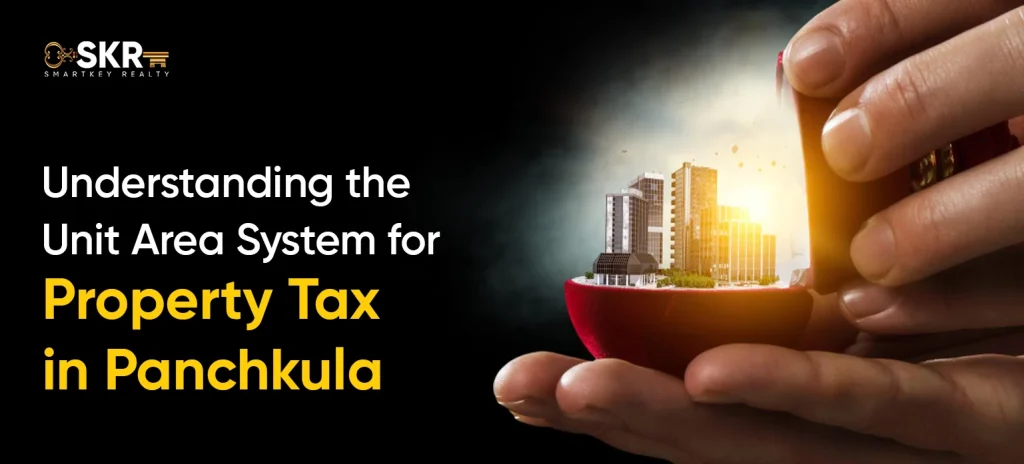
Property tax bills across Panchkula have jumped significantly. Commercial establishments are paying double or triple what they paid last year. Residential property owners are seeing similar increases. The reason is a complete overhaul of how the municipal corporation calculates property tax.
The switch from Annual Rental Value to Unit Area System affects every property in the city. Business owners need to understand this change because it directly impacts operating costs and financial planning. Getting the assessment wrong means paying thousands more than necessary.
The Basic Calculation Method
The Unit Area System uses a simple formula: built-up area × fixed rate × age factor = annual tax. The built-up area includes all covered spaces—offices, storage, hallways, bathrooms, and covered parking. Rates vary by property type and location; commercial rates exceed residential. Age discounts (maximum 10%) apply to older buildings. Additional charges (water, sewerage, lighting, education cess) add approximately 20% to base calculations.
Why Panchkula Adopted This System
The old method used estimated rental values, creating inconsistent assessments for similar properties. Haryana mandated this standardized system for transparency and consistency using measurable data. It increases municipal revenue for infrastructure while providing property owners with clarity, assessments are online, calculations verifiable, making corrections easier to identify.
Real Numbers for Different Properties
A 1,500 sq ft residential property in Sector 20: ₹15/sq ft × 0.90 age factor = ₹20,250 base (₹24,000 total with charges).
Same area commercial: ₹45/sq ft × 0.90 = ₹60,750 base (₹70,000+ total), three times residential rates. Larger commercial premises exceed ₹1 lakh annually. Rate differences significantly impact shops, clinics, offices, and restaurants.
Also Read: Residential Property in Mohali
Common Assessment Errors
Measurement errors showing larger areas than the actual are most common. Misclassification (residential as commercial) triples taxes. Sector coding mistakes near boundaries apply the wrong rates. An incorrect building age means paying 10-15% extra annually. Exemptions for seniors, disabled persons, and eligible categories require manual claims; they’re not automatic. Verify all details; errors cause significant overpayment and compound yearly.
Checking Assessment Accuracy
Download your assessment from the municipal portal. Compare built-up areas with approved building plans. Measurement errors are common.
Verify property classification matches actual use. Confirm the correct sector code and location. Check that the construction year aligns with the completion certificates. Wrong details mean incorrect taxes; checking classification or sector errors early prevents costly mistakes.
Filing Corrections
Property owners get 30 days from the assessment notice to file objections. The municipal portal handles these submissions online.
Objections need specifics, not general complaints. Saying “the tax is too high” doesn’t work. Pointing out “assessment shows 2,000 sq ft, but building plan shows 1,650 sq ft” gets results.
Supporting documents matter. Approved building plans carry the most weight. Property registration papers, previous tax receipts, and relevant certificates all help.
The municipal office schedules re-inspections for valid objections. Someone should be present during these visits. Make sure measurements use proper tools, not rough estimates.
Most genuine errors get fixed during this process. Resolution typically takes 4-6 weeks. If the objection gets rejected, appeals can go to the District Collector’s office, though that requires more formal procedures.
Financial Impact on Businesses

This is now a permanent operating expense. Businesses need to build it into annual budgets just like rent and utilities.
A 2,500 square foot retail store in a good location can face ₹1-1.5 lakh annual property tax. For restaurants or clinics with larger premises, bills reach ₹2 lakh or more. These are not small amounts for most businesses.
Location decisions now carry tax implications. Operating in prime sectors means significantly higher tax costs. Some businesses are considering relocation to lower-tax areas.
Property investors need to factor this into return calculations. Buying commercial property means accepting a substantial annual tax liability that affects rental yields.
Planning Ahead
Municipal corporations revise rates every few years. Expect increases of 5-10% when revisions happen. Prime locations typically see bigger jumps than developing areas.
The calculation method stays the same even when rates change. Once someone understands their current assessment, predicting future costs becomes easier.
Many municipal corporations offer early payment discounts of around 5-10%. For businesses with decent cash flow, this is worth considering.
Setting aside money monthly works better than scrambling at payment time. Treating property tax like any other recurring expense makes it manageable.
Payment and Compliance
Late payments cost money. Interest charges run 1-1.5% per month, which adds up to 12-18% annually. That’s expensive money.
Extended non-payment creates bigger problems. Legal notices follow. Property can get attached. Municipal clearances get denied. Can’t sell property or get building approvals with outstanding tax.
The online payment system works well. Accepts multiple payment methods. Provides instant receipts. Keeps digital records that simplify documentation.
Also Read: Residential vs Commercial Property Tax in Chandigarh Explained
Action Points
Check assessments as soon as they arrive. Keep all property documents organized and accessible. Building plans, tax receipts, correspondence with authorities – everything might be needed.
File objections quickly within the 30-day deadline.
Budget annually for taxes. For disputed measurements, hire private surveyors. The Unit Area System calculations and planning are accordingly, thereby ensuring better property tax management.




